Intro
In our recent Mtn Bike 201 article, we covered the various rubber compound and casing options from a few of the popular tire manufacturers whose tires we’re reviewing here. Now it’s time to dive into specific tread patterns.
As noted in that article, this isn’t a comprehensive overview of every tread pattern offered from each brand; this guide is focused primarily on models designed for “aggressive Trail” through DH use, and the tires chosen reflect that. We also haven’t been able to spend time on every conceivable option in that space, but we will be adding to and updating this guide as we test new tires (including options from other brands). You can also click here for more reviews of other tire models (including more XC-oriented tires).
It’s important to consider width, casings, and rubber compounds in addition to just the tread pattern when evaluating tires (which is also why that compounds & casings article is important for this one). Where practical, we’ve attempted to test tires in multiple casing and rubber options to get a feel for how they perform in a range of constructions.
When describing performance differences between different tread patterns from different brands, the comparisons refer to how the most similar versions (in terms of similar casings / compounds from other brands) of the tires compare. Unless specifically discussed, it’s fair to assume that the general performance tradeoffs between harder and softer rubber compounds, discussed in our 201 article, apply here. And if you need a refresher about the general construction and attributes of mountain bike tires, check out our Tires 101 article.
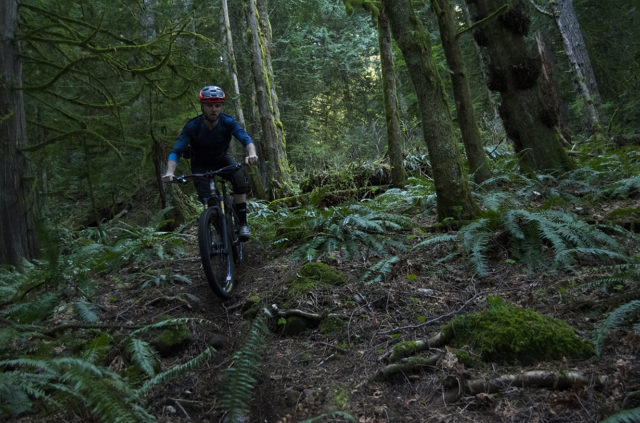
A few quick notes to start:
(1) This guide predominantly covers tread designs that make sense for use on “Trail” bikes through DH bikes (which, I’d argue, are pretty much the same set of tread patterns, albeit in different casings and perhaps rubber compounds).
(2) We’ve included some measured specs for all the tires, with all measurements being taken on a 30 mm internal-width rim, unless otherwise noted.
(3) For more detail on each brand’s different rubber compound and casing options, you can check out this article. In this comparison of tread patterns, we’ll cover which rubber compounds, casings, and sizes that a given tread pattern is offered in as an overview, but in many cases, those tires won’t be offered in every possible combination of rubber / casing / size. For that minutiae, you’ll want to go to the tire manufacturers’ websites.
Maxxis
Maxxis Minion DHF
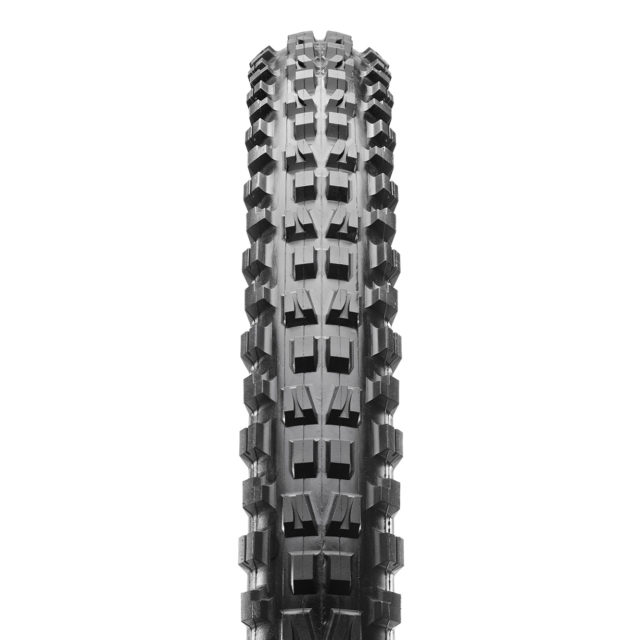
- Diameters available: 24”, 26”, 27.5”, 29”
- Widths available: 2.3”, 2.5” & 2.6”; 2.4” only in 24” diameter
The Minion DHF has been a mainstay tire for aggressive riders for nearly two decades now, and Noah Bodman and I went so far as to name it our product of the 2000s in Episode 13 of our Bikes and Big Ideas podcast. The DHF stands out largely due to its versatility; there are few situations where it feels wildly out of place, and its predictability is a defining characteristic. Even in conditions for which it’s not ideally suited, the DHF breaks traction smoothly, controllably, and with considerable feedback and warning that you’re approaching its limit of grip.
Compared to a lot of newer designs, the DHF has a somewhat more rounded profile, which, combined with its large open channel between the center and side knobs, can create a sensation of needing to commit to leaning over the tire into a corner to engage the side knobs and get past that open channel. The upside is that that open channel provides ample room for an aggressive rider to really dig in the side knobs, and in most conditions, the DHF’s cornering grip is quite good. The potential downside is that more cautious riders may not like the “vague” or “drifty” feeling when they aren’t leaning the DHF over at a higher angle during a turn, and consequently not fulling digging in its side knobs.
Given its relatively aggressive tread, the DHF rolls a bit better than average, has mediocre braking traction, and corners well in most conditions. It also performs notably well in situations where lateral grip is needed when riding on the center knobs (e.g., off-camber, wet roots). In terms of conditions, the DHF isn’t in its element in truly wet, horrendous conditions, but is a good generalist that performs admirably almost everywhere else.
Exo, Exo+, DoubleDown, Downhill
Dual, 3C MaxxTerra, 3C MaxxGrip, Super Tacky
- 27.5” x 2.5”, Exo, MaxxGrip: 1008 g
- 27.5” x 2.5”, DoubleDown, MaxxGrip: 1158 g
- Measured width for 2.5” tire, casing: 2.36”
- Measured width for 2.5” tire, tread: 2.52”
Front; rear if you want something that rolls faster than a DHR II
Most conditions, apart from very wet or soft & loose
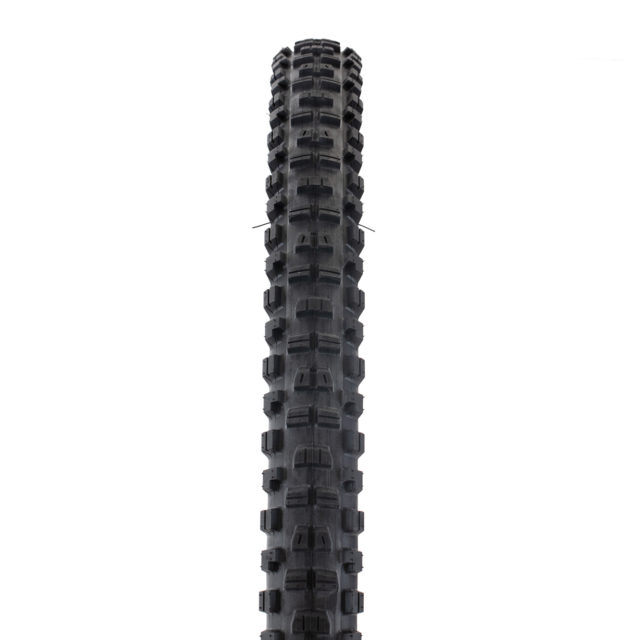
- Diameters available: 24”, 26”, 27.5”, 29”
- Widths available: 2.3”, 2.4” & 2.6”
The original Minion DHR was released alongside the DHF and, yes, the “F” and “R” do stand for Front and Rear, which were the intended uses for the two. But while the DHF was a smash hit, the original DHR left a lot to be desired, and many riders at the time opted to run DHFs front and rear.
The updated DHR II (released back around 2011) shares essentially the same side knob design as the DHF, but pairs those side knobs with much broader center knobs and a slightly more squared-off overall profile. The result is a tire that offers tremendously better braking traction than the DHF, rolls a bit slower, and slightly minimizes the DHF’s open transition from center to side knobs.
Like the DHF, the DHR II can actually work well on both ends of the bike, depending on your priorities. Though far more braking power comes from the front end — due to the forward weight shift that occurs under braking — braking traction is often more limited in the rear for precisely the same reason (less weight on your rear tire means less braking grip available out of the rear). Rear tires also have a greater overall impact on rolling resistance, and the DHR II doesn’t quite match the DHF’s grip on wet roots and rocks. [The very long, and substantially siped center knobs of the DHF are to credit here; the DHR II trades those for vastly better braking performance].
The DHR II makes sense as a front tire if you’re inclined to maximize braking traction and can live with its reduced lateral grip when riding on the center knobs as compared to the DHF. As a rear tire, the DHR II’s increased rolling resistance is the only real downside as compared to the DHF, and its far better braking traction makes up for that for many people, which is why you see so many people running a DHF up front and DHR II out back. The DHR II sheds mud a touch better than the DHF, but they’re similarly versatile in terms of the conditions in which they perform well.
Exo, Exo+, DoubleDown, Downhill
Single, Dual, 3C MaxxTerra, 3C MaxxGrip, Super Tacky
- 27.5” x 2.4”, Exo, MaxxTerra: 892 g
- 27.5” x 2.4”, Exo+, MaxxTerra: 975 g
- 27.5” x 2.4”, DoubleDown, MaxxTerra: 1058g
- 27.5” x 2.4”, DoubleDown, MaxxGrip: 1157g
- 27.5” x 2.4”, Downhill, Folding Bead, MaxxGrip: 1243 g
- Measured width for 2.4” tire, casing: 2.29” (average)
- Measured width for 2.4” tire, tread: 2.37” (average)
Front and rear
Most conditions, apart from very wet or soft & loose
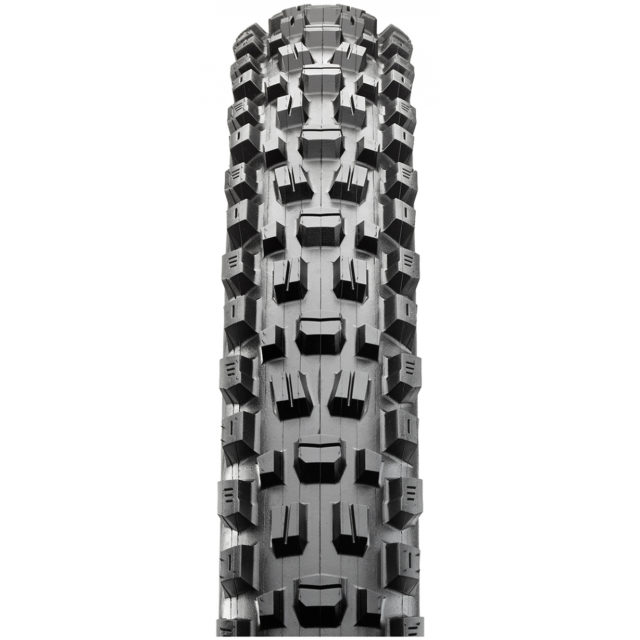
- Diameters available: 27.5”, 29”
- Widths available: 2.5” & 2.6”
The Assegai is a somewhat newer offering from Maxxis, intended to take some of the strong points of the DHF recipe but improve upon the braking performance and offer more consistent grip across a variety of lean angles. Broadly speaking, it succeeded in those goals, but those design criteria do come with some tradeoffs.
The Assegai rolls notably slower than the DHF — it’s closer to, or maybe a touch slower than the DHR II in that regard — and its braking performance falls somewhere between the two Minion variants.
The Assegai does offer more cornering grip than the DHF or DHR II at shallow / moderate lean angles, but that does come somewhat at the expense of being able to really, fully dig in the corner knobs in soft, supportive soil (i.e., perfect hero dirt).
The Assegai does best in fairly dry, loose conditions, where traction and support are limited. It doesn’t offer wildly more lateral grip than the DHF or DHR II in those conditions, but is more consistent and predictable when the soil is anything but predictable — especially when the trail conditions offer such little traction that it’s challenging to achieve high lean angles to fully engage the side knobs on something like the DHF. For that reason, some of our less aggressive reviewers have found themselves preferring the Assegai especially as a front tire, which is worth noting if you find yourself hesitant to really trust and lean over your tires on flat, loose-over-hard conditions.
Exo, Exo+, DoubleDown, Downhill
Dual, 3C MaxxTerra, 3C MaxxGrip
- 27.5” x 2.5”, Exo+, MaxxTerra: 1073 g
- 27.5” x 2.5”, Downhill, Folding Bead, MaxxGrip: 1327 g
- Measured width for 2.5” tire, casing: 2.32” (average)
- Measured width for 2.5” tire, tread: 2.44” (average)
Front; rear if lateral grip on loose, dry soil is a top priority
Ideally suited to drier conditions but still serviceable for occasional wet-weather use
Maxxis Shorty
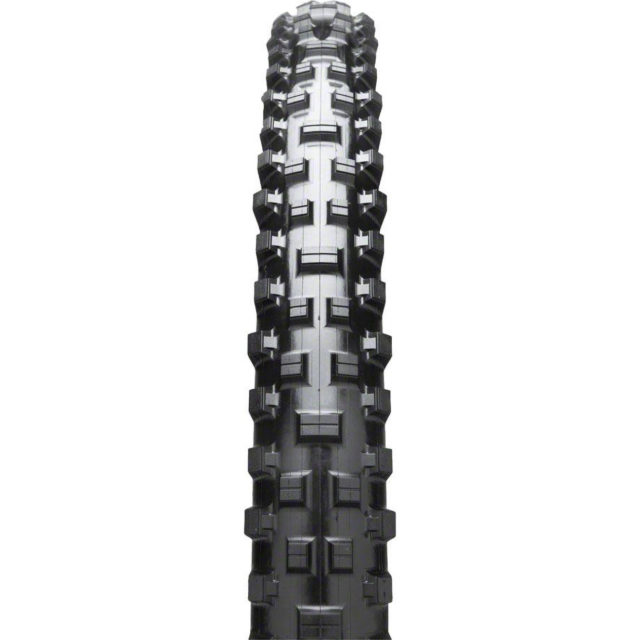
- Diameters available: 26”, 27.5”, 29”
- Widths available: 2.3”, 2.4” & 2.5”
The Shorty is Maxxis’s mid-spike tire — meant to work best in very soft, loose conditions. Maxxis actually mentions dry, “blown out” conditions before mud in their description, but the Shorty is intended to work in both, and be more versatile than a more specific, “true mud spike.”
As with most tires with a spiky, open-tread pattern, the Shorty rolls fairly slowly and doesn’t inspire a ton of confidence on firmer terrain, be it hardpack or roots and rocks. The Shorty is best suited to very soft conditions and makes more sense as a front tire than a rear most of the time, due to rolling-resistance considerations and its tendency to feel squirmy and vague on harder surfaces.
As Maxxis’s description suggests, the Shorty works better in dry, loose conditions than it does in super wet, loose conditions, but it’s a respectable option for both. The biggest downside to the Shorty in the wet is that its lateral grip on wet roots isn’t very strong, and wet roots and wet soil tend to go hand in hand. If your trails don’t have a ton of exposed roots, this obviously doesn’t matter as much — in soft, wet soil, the Shorty’s braking and cornering grip are both very good.
The Shorty is a somewhat specialized tire that’s far less versatile than many of the tires here that are designed to work in a broad range of conditions, but does perform admirably in the ones for which it’s designed.
3C MaxxTerra, 3C MaxxGrip, Super Tacky
- 27.5” x 2.5”, Exo, MaxxTerra: 998 g
- 27.5” x 2.5”, Double Down, MaxxGrip: 1197 g
- Measured width for 2.5” tire, casing: 2.28” (average)
- Measured width for 2.5” tire, tread: 2.45” (average)
Front; rear if conditions are extremely loose and rolling resistance isn’t a top priority
Dry and very loose, or wet and muddy
Schwalbe
Schwalbe Magic Mary
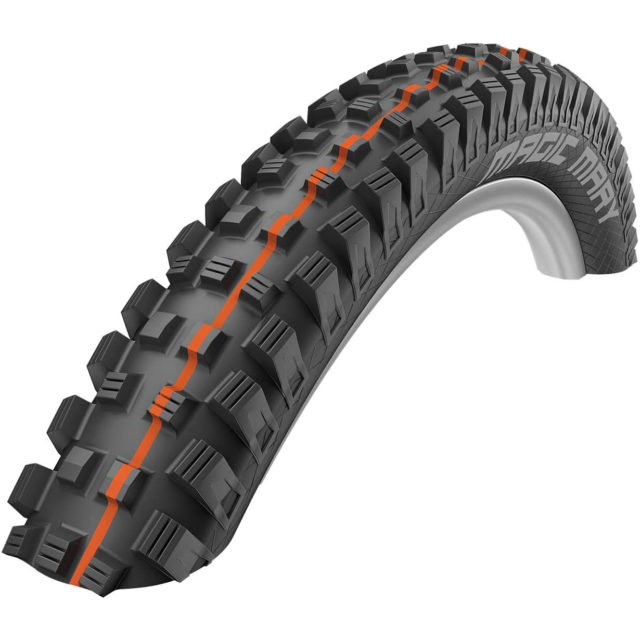
- Diameters available: 26”, 27.5”, 29”
- Widths available: 2.35’’ (26’’ only, for 2021 onward), 2.4’’, 2.6’’, & 2.8’’
The Magic Mary is Schwalbe’s aggressive gravity tire, intended for use in a broad range of conditions. Compared to many other tires in that category, the Magic Mary’s tread design is notably open and spiky. As such, the Magic Mary is at its best in somewhat softer, looser conditions; on very hard surfaces it can feel a little squirmy, and its rolling resistance suffers compared to the less spiky options, such as both Maxxis Minion variants or the e*thirteen AT Gen 3 (more on those in a bit).
The Magic Mary’s braking traction is quite strong — again, especially in softer soil — and its cornering grip is substantial. With partial transition knobs between the center and side knobs, the Magic Mary’s lateral grip is relatively consistent across a range of lean angles; the Magic Mary is more like the Assegai and less like the Minion DHF in that regard. For more on what “transitional knobs” are, see our Tires 101 article.
Where the Magic Mary is lacking, however, is in terms of predictability. Though it does grip well in many different conditions, the transition from gripping to breaking into a drift can happen abruptly, and with little feedback to give you warning. Despite feeling like it offers more max cornering grip than the Minion DHF or DHR II in some circumstances — and significantly stronger braking — I’m less comfortable pushing the Magic Mary to the limit for precisely this reason.
For 2021, Schwalbe tweaked the available sizes for the Magic Mary slightly, but the overall design hasn’t changed significantly.
- Measured width for 2.35” tire, casing: 2.31”
- Measured width for 2.35” tire, tread: 2.32”
Most conditions, especially on the softer / looser end of that spectrum
Schwalbe Big Betty
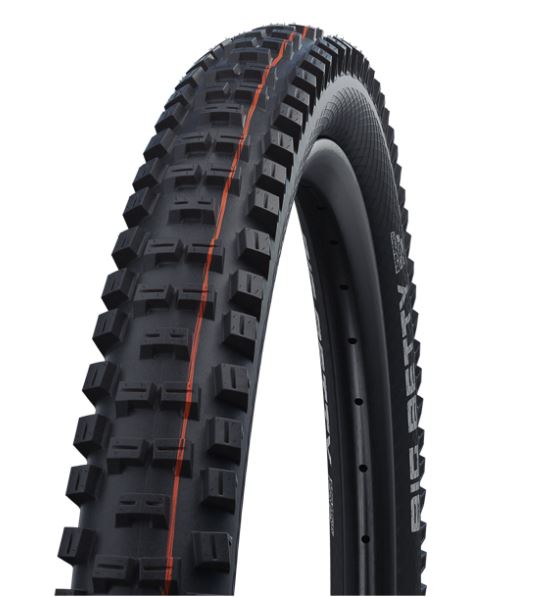
- Diameters available: 26’’, 27.5’’, 29’’
- Widths available: 2.4’’, 2.6’’, 2.8’’
The Big Betty is a name that Schwalbe has used in the past, and after a long hiatus, it’s back — as a completely different tire than previous versions.
Schwalbe designed the new Betty to be a rear tire for all-round / mixed conditions, a void that was largely unfilled in their lineup, for riders looking for a fairly aggressive tire that rolls faster than the Magic Mary. The Big Betty features wide, blocky center knobs and a bit of a channel between them and the side knobs, though that channel is narrower than on a lot of similar tires, most notably the Maxxis Minion DHR II. Compared to the DHR II, the Betty rolls slightly faster, but gives up a little bit of braking and cornering traction, especially on softer, looser surfaces. The Big Betty also requires notably less commitment to get over onto the side knobs than the DHR II, and riders who have found the wide channel on the Minions to be disconcerting should give the Betty a look.
Both the center and side knobs on the Big Betty are tighter spaced than those on the DHR II. While this is likely a big part of why the Betty rolls faster, it does also mean that it doesn’t clear mud as well. You can also think of the Big Betty as spanning the gap between the DHR II the e*thirteen AT Gen 3, which is decidedly more oriented towards drier, firmer conditions than the DHR II. Compared to the e*thirteen, the Big Betty offers more braking traction, in particular, on looser, wetter surfaces, and is more predictable on wet roots and rocks.
- 27.5’’ x 2.4’’, Super Trail, Soft: 1251 g
- 27.5’’ x 2.4’’, Super Gravity, Soft: 1272 g
- Measured width for 2.4’’ tire, casing: 2.41’’
- Measured width for 2.4’’’ tire, tread: 2.31’’
Schwalbe Dirty Dan
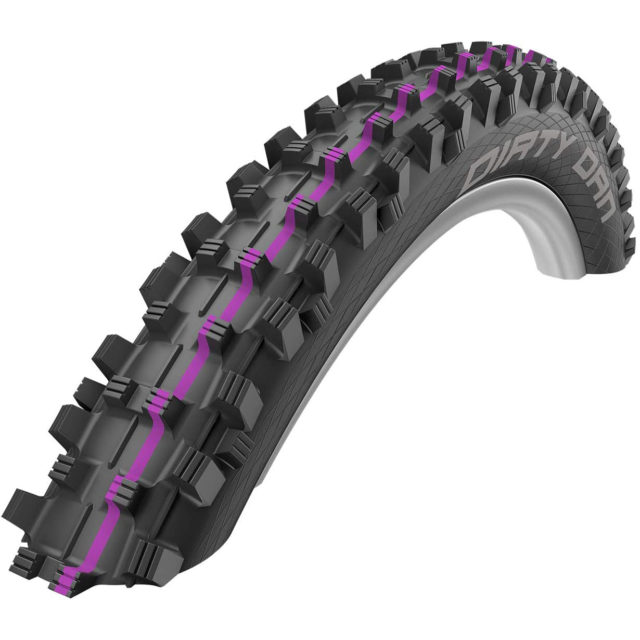
- Diameters available: 27.5’’, 29’’
- Width available: 2.35”
The Dirty Dan is Schwalbe’s mid-spike, wet-weather tire, designed to offer excellent soft-condition, wet-soil performance while continuing to be serviceable if conditions dry out a bit.
In soft, wet soil, the Dirty Dan is superb. Its braking traction is exceptional in these conditions, and while no tire corners great when conditions are wet and slippery, the Dirty Dan manages uncommonly well, while also being remarkably consistent and predictable. That combination of substantial grip and a high degree of consistency and predictability in super wet conditions is rare. Plenty of tires can dig into soft soil but then abruptly give out when the soil does, and plenty can slide around in the wet in a way that’s consistent and predictable, but without ever gripping all that well. The way that the Dirty Dan manages to blend those two traits is impressive, and has made it my go-to front tire in wet, Western Washington winter and spring seasons.
As tends to be the case with tires with open, spiky tread designs, the Dirty Dan rolls fairly slowly and can feel somewhat vague and squirmy on firmer ground, but for how well it works in truly wet, terrible conditions, the Dirty Dan is remarkably versatile. That’s not to say that I’d recommend it for use outside of relatively soft, loose soil, but it’s not a tire that feels like it’s trying to kill you the moment you take it out of its element.
Given that it does roll slowly and is only available in Schwalbe’s ultra-sticky Addix Ultra Soft rubber, I’ve mostly preferred to pair the Dirty Dan up front with a Minion DHR II in the rear (for rolling resistance and durability reasons).
Addix Ultra Soft
27.5” x 2.35”, Super Gravity, Ultra Soft: 1135 g
- Measured width for 2.35” tire, casing: 2.38”
- Measured width for 2.35” tire, tread: 2.25”
Front; rear if conditions are very wet and rolling resistance isn’t a top priority
Wet and muddy
Schwalbe Nobby Nic
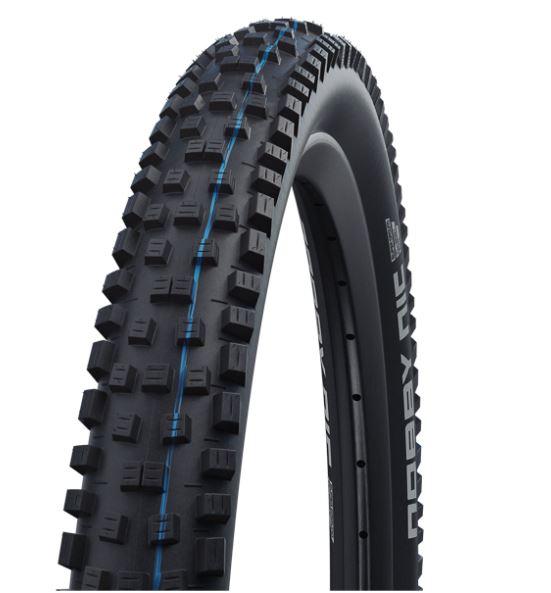
- Diameters available: 26'', 27.5'', 29’’
- Widths available: 2.25'', 2.35'', 2.4'', 2.6'', 2.8''
The Nobby Nic is a bit less aggressive than most of the tires included in this guide, but it’s also an interesting option for riders looking for a lighter, faster -rolling tire, — especially on the rear. Though the Nobby Nic name has been in the Schwalbe lineup for a long time now, the tire just got a substantial redesign. In particularMost notably, the side knobs are much meatier and better supported than on the old model.
The new Nic rolls very well, offers reasonable braking bite, (especially on firm surfaces), and is especially consistent in how much lateral grip it offers across a wide range of lean angles. Peak cornering grip is not as strong as many of the tires here, especially as conditions get softer and looser, but . But for less-aggressive riders who aren’t trying to rip their side knobs off through every corner, or folks who really don’t like the sensation of needing to lean the bike dramatically to engage the side knobs, it’s a very good option.
Befitting the Nic’s more XC / Trail intentions, it’s only available in Schwalbe’s light- and mid-weight Super Ground and Super Trail casings. Those seem like perfectly sensible choices for this sort of tire, but people looking for a fast -rolling rear tire to really push hard on their Enduro or DH bikes would probably want to look elsewhere.
As a lighter-duty Trail bike rear tire though, the Nic is going to work really well for a lot of people — and I could even see some riders putting them on the front of a relatively XC-oriented bike, especially in the lighter Super Ground casing. It rolls well, brakes passably, and is highly consistent and predictable — all great traits for a slightly mellower Trail bike tire, which is exactly what the Nic is supposed to be.
Super Ground, Super Trail
Addix SpeedGrip, Addix Soft
27.5” x 2.35”, SuperTrail, Addix SpeedGrip: 1012 g
- Measured width for 2.35” tire, casing: 2.33”
- Measured width for 2.35” tire, tread: 2.33”
Rear; front if rolling resistance is a top priority.
Firm to mixed
e*thirteen
e*thirteen All-Terrain Gen 3
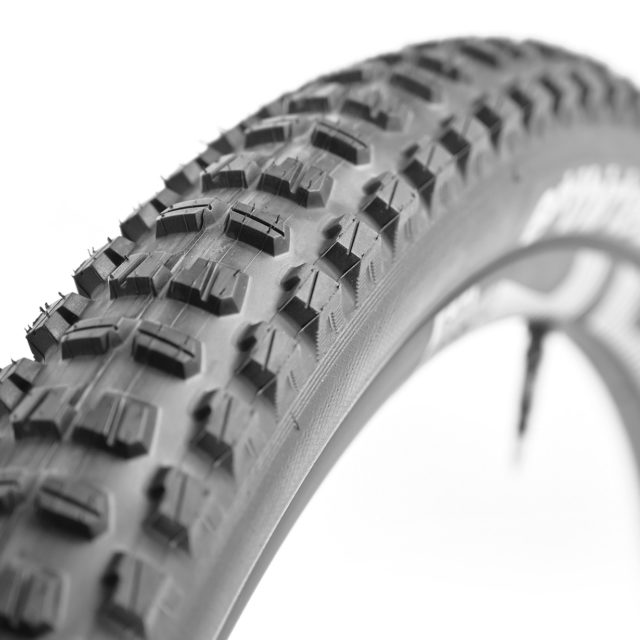
- Diameters available: 27.5”, 29”
- Width available: 2.4”
e*thirteen’s naming of the All-Terrain Gen 3 is refreshingly straightforward, if a little clunky; I’ll give no prizes for guessing that it’s the third generation of their take on a versatile tire that’s meant to work in a broad range of terrain.
Compared to the prior iteration, the AT Gen 3 has dramatically broader, chunkier center knobs — which look a bit like a blend between those on the Minion DHF and DHR II — and a significantly more rounded profile.
The AT Gen 3 does indeed feel like a bit of a mix of the DHF and DHR II; the AT Gen 3’s braking traction is somewhere between the two and the AT Gen 3 also features a sizable channel between the center and side knobs, which requires some commitment to lean through and engage the side knobs. The AT Gen 3 is the fastest rolling of the three — credit its slightly shorter, stiffer center knobs for that.
The AT Gen 3 is perhaps best viewed as something like a variant on the Minion theme, but oriented a touch more towards dry, firm conditions. Compared to either Minion version, the AT Gen 3 gives up a little bit of traction, especially while cornering, when presented with very loose, soft conditions, but is less squirmy and more supportive when conditions trend toward hardpack, or shallow amounts of loose over hard. For variable to dry conditions, short of fully blown-up, loose, moon dust, the AT Gen 3’s performance is excellent.
Unfortunately, there’s a downside — along with the e*thirteen Semi-Slicks described below, the AT Gen 3 is definitely the most difficult tire to mount compared to the other options here. The issue seems to be that the bead is just a touch tight, and on rims without a fairly deep center channel to drop the bead into, there just isn’t enough total length of the bead for things to go smoothly. In fact, when the AT Gen 3 tires were brand new, I was completely unable to mount them on the first wheels I tried, a pair of We Are One Agents.
Mounting on subsequent wheels — including DT XM481, DT EX 471, DT EX511 rims, as well as the newer We Are One Unions — was doable, but with notably greater effort than most other tires. I was also later able to install the TRS construction e*thirteen AT Gen 3 on the Agents once the tires had been mounted on another set of wheels for a few weeks and apparently stretched slightly, but did not have any such success with the beefier LG1 EN versions.
- 27.5” x 2.4”, TRS, MoPo: 993 g
- 27.5” x 2.4”, LG1 R EN, MoPo: 1108g
- 27.5” x 2.4”, LG1 R EN, Race: 1120g
- Measured width for 2.4” tire, casing: 2.36” (average)
- Measured width for 2.4” tire, tread: 2.40” (average)
Variable, especially on the drier/firmer end of that spectrum
e*thirteen Semi-Slick
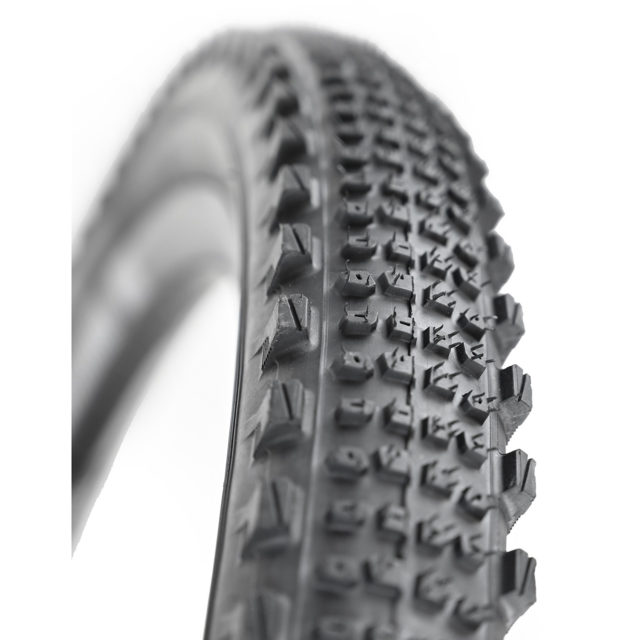
- Diameters available: 27.5”, 29”
- Width available: 2.35"
e*thirteen’s Semi-Slick is just that — a semi-slick version of the AT Gen 3. The two share somewhat similar side knobs, but those on the Semi-Slick are spaced slightly farther apart and lack the stepped L-shaped hook that the AT Gen 3 features. The center knobs are where the big changes appear — in keeping with the semi-slick design, the e*thirteen Semi-Slick’s center knobs are very low, small, and more tightly spaced.
As one would expect of a semi-slick, e*thirteen’s version rolls very well, at the expense of braking and pedaling traction. The e*thirteen Semi-Slick also feels quite loose and drifty until the side knobs are engaged, given the modest center knobs and notable channel between them and the side knobs.
The overall profile is an important design element on any tire, but it’s especially so on a semi-slick. Since the side knobs are the only ones of any real size on this sort of tire, the shape of the tire profile heavily dictates how and when the transition onto the side knobs occurs. e*thirteen did an excellent job with the Semi-Slick; the tire is slightly rounded overall, to keep the side knobs out of play (and consequently not really impacting rolling resistance) when the bike is upright, but not overly round to the point that engaging the side knobs requires extreme lean angles. For a fast-rolling tire for dry conditions that still corners reasonably well, the e*thirteen Semi-Slick is excellent.
Unfortunately, the same mounting challenges that I mentioned in the AT Gen 3 apply here as well. It’d be great to see e*thirteen loosen up the beads on these tires ever so slightly because they’re very good tires otherwise.
- Measured width for 2.35” tire, casing: 2.28”
- Measured width for 2.35” tire, tread: 2.36”
Hardpack; more varied conditions if rolling resistance is a top priority and braking and pedaling traction aren’t.
WTB
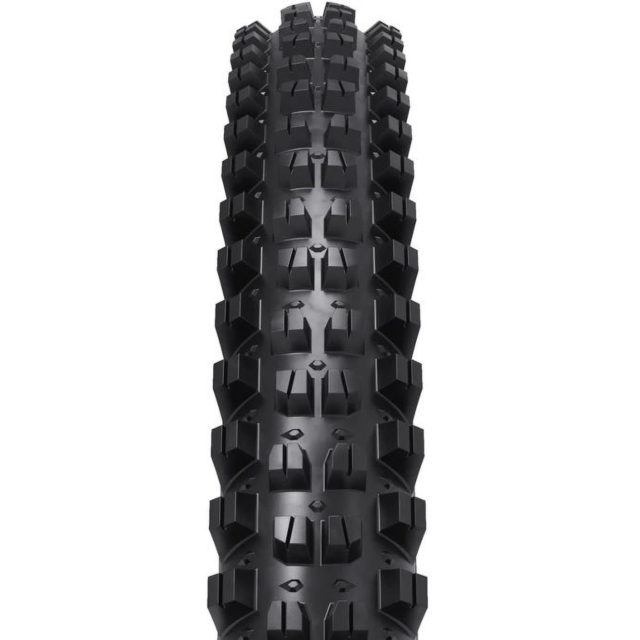
- Diameters available: 27.5”, 29”
- Width available: 2.5”
The Verdict is WTB’s take on an aggressive front tire and features a very open, spiky tread pattern and a somewhat squared-off profile. It’s also notably high volume compared to most other tires of similarly nominal width. You can read our full review of the Verdict and the WTB Judge here, but the main points are that the Verdict is a tire that’s best suited for soft soil, and is especially grippy at somewhat moderate lean angles (particularly compared to a similar tire without transitional knobs, like the Maxxis DHF).
This might sound somewhat reminiscent of the Maxxis Assegai and Schwalbe Magic Mary, but the way those tires achieve grip at shallow lean angles is pretty different; while the Assegai and Magic Mary incorporate transition knobs to fill the gap between the center and side knobs, the Verdict’s tall side knobs and relatively square profile mean that the side knobs engage sooner as you start to lean the bike over. There’s still a notable channel between the Verdict’s center and the side knobs, but it doesn’t take much to lean past it.
The downside is that the Verdict’s combination of very high volume, a fairly square profile, and tall, spiky knobs with lots of longitudinal sipes makes for a tire that can be a bit squirmy and vague under hard cornering at high lean angles. As Noah said in his full review, I suspect that the Verdict might work better in really loose, sandy dirt (or fully blown-up moon dust). For better or worse, (better for me and Noah, worse for any of you who might have to regularly deal with those kinds of conditions and would want to know how the Verdict handles them), we haven’t had much opportunity to test that thesis, but we’ll post an update if we do.
- 27.5” x 2.5”, TCS Light, High Grip: 1156 g
- 27.5” x 2.5”, TCS Tough, High Grip: 1272 g
- Measured width for 2.5” tire, casing: 2.39”
- Measured width for 2.5” tire, tread: 2.54”
Soft soil, especially for riders looking for a high-volume tire that grips well at moderate lean angles.
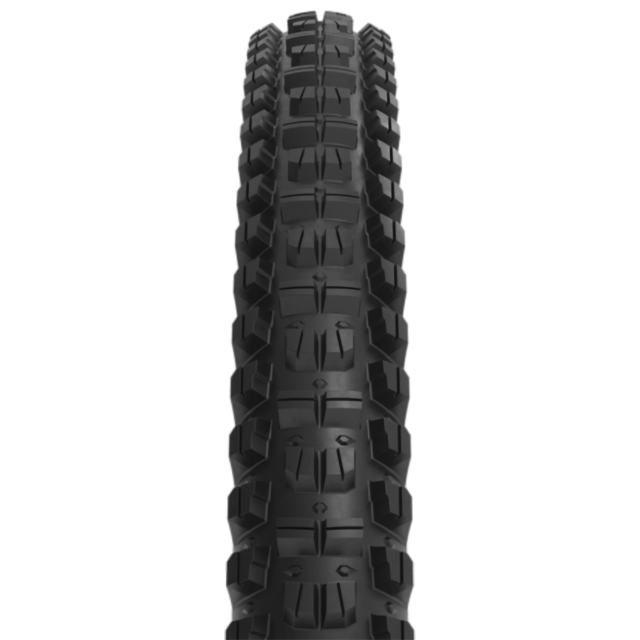
- Diameters available: 27.5”, 29”
- Width available: 2.4”
The Judge is WTB’s aggressive rear tire, and at a quick glance bears a significant resemblance to the Maxxis Minion DHR II. There are some notable differences, though; the Judge has a more square overall profile, taller side knobs, and more longitudinal sipes in the side knobs. The L-shaped portions of the Judge’s side knobs are also oriented in the opposite direction to the DHR II. Frankly, Maxxis’s design makes more sense to me; those L-shaped hooks give an extra edge to dig into the soil, and as they’re oriented on the DHR II, they serve to aid braking, whereas, on the Judge, they’re adding pedaling traction — something that seems less necessary out of the side knobs on a tire (particularly one in this more aggressive-traction category).
Overall, as compared to the DHR II, the Judge is a bit higher volume and the Judge’s spikier knobs and more squared-off profile make for a tire that grips better in very soft soil and at shallower lean angles, but one that, like the Verdict, can be overwhelmed by very aggressive, hard cornering at high lean angles, especially on firmer soil. I’d point to the Judge’s square overall profile and heavily siped side knobs as the likely reasons for this. The Judge’s braking traction is very good — again, especially in soft, loose soil — but the Judge is on the slower-rolling side of the spectrum. I’d place its rolling resistance between the Minion DHR II and Magic Mary.
The Judge makes the most sense as a rear tire for riders who want a burly, high-volume option that works well in soft, loose soil, and that requires less commitment to lean over and engage the side knobs than something like a Minion DHR II.
- 27.5” x 2.4”, TCS Tough, High Grip: 1235 g
- 27.5” x 2.4”, TCS Tough, Fast Rolling: 1288 g
- Measured width for 2.4” tire, casing: 2.22”
- Measured width for 2.4” tire, tread: 2.4”
Michelin
Michelin Wild Enduro Front
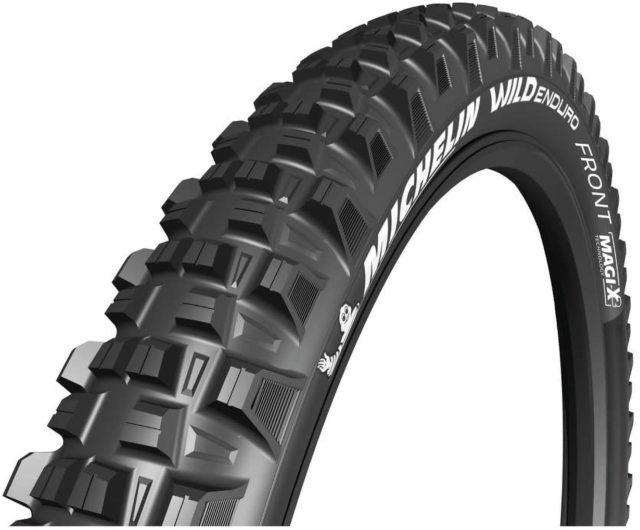
- Diameters available: 26", 27.5”, 29”
- Width available: 2.4”, 2.6", 2.8"
The Wild Enduro Front is, as the name would suggest, Michelin’s take on an aggressive Trail / Enduro front tire. It’s a fairly open tread design, with somewhat smaller center knobs and partial transition knobs, paired with extremely well supported but somewhat widely spaced side knobs.
The result is a fast-rolling tire with respectable cornering grip on hardpack and loose-over-hard surfaces, and performance characteristics that are rather unlike anything else in this guide. The Wild Enduro Front rolls very fast for a tire I’d consider for use up front; it brakes well for such a fast-rolling tire, feeling roughly on par with the Minion DHF, but notably worse than some slower-rolling options like the Minion DHR II; and feels most comfortable in dry, mostly firm conditions.
The Wild Enduro Front’s cornering grip is passable, especially on relatively firm, dry surfaces, but isn’t particularly strong for the category of tires covered in this guide; the Minion DHF and DHR II, Schwalbe Magic Mary, and e*thirteen AT Gen 3 all corner better in dry conditions. Rather than being a super aggressive, ultra-grippy Enduro tire, the Wild Enduro Front is probably best thought of as a fast-rolling Trail bike tire for dry conditions.
The Wild Enduro Front features a version of Michelin’s “Gravity Shield” casing, but in a different construction than the Wild Enduro Rear, which is also described as featuring Gravity Shield. The Front tire uses a 3-ply, 60-TPI casing that feels fairly comparable to Maxxis Exo in terms of weight and toughness.
27.5” x 2.4”, Magi-X2: 999 g
- Measured width for 2.4” tire, casing: 2.37”
- Measured width for 2.4” tire, tread: 2.36”
Dry and firm, and loose over hard
Michelin Wild Enduro Rear
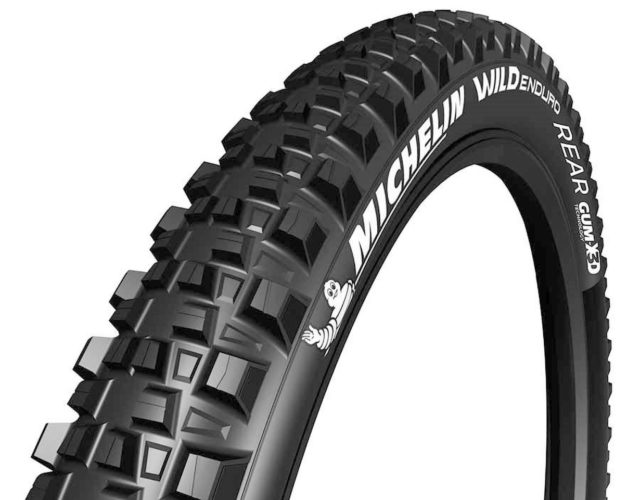
- Diameters available: 27.5”, 29”
- Width available: 2.4”
The Wild Enduro Rear bears a strong resemblance to the Wild Enduro Front, but with tighter-spaced and somewhat lower-profile knobs. As with its Front counterpart, the Wild Enduro Rear is a fast-rolling tire best suited for dry, firm conditions. Compared to something like the e*thirteen Semi-Slick, the Wild Enduro Rear rolls a touch slower, brakes notably better, and isn’t as loose and drifty before the side knobs are fully engaged. The Wild Enduro Rear is a good option for riders looking for a fast-rolling tire for dry conditions that doesn’t go quite as all-in as a semi-slick when it comes to trading off grip for a reduction in rolling resistance.
As with the Wild Enduro Front, the Wild Enduro Rear comes in a single casing option that Michelin labels “Gravity Shield,” but it’s a 3-ply, 33-TPI version that’s slightly thicker / tougher, and correspondingly heavier, than the Front. Maxxis’s Exo+ casing is probably the closest comparison from the other brands here.
Gravity Shield 3×33 TPI
27.5” x 2.4”, Gum-X3D: 1087 g
- Measured width for 2.4” tire, casing: 2.34”
- Measured width for 2.4” tire, tread: 2.34”
Dry and firm, and loose over hard
Michelin DH22
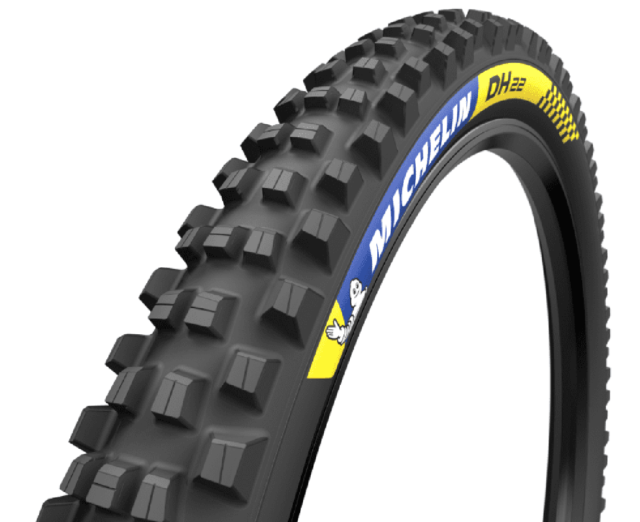
- Diameters available: 27.5”, 29”
- Width available: 2.4”
After a lengthy hiatus, in which they didn’t offer any true downhill tires, Michelin is back with two of them. The DH22 is their DH tire intended for “soft and mixed terrain,” and it excels there — and has been ridden to EWS domination by a certain retired downhiller / noted flat-pedal enthusiast…
The DH22 tread pattern looks a bit like a Schwalbe Magic Mary, but with bigger, more buttressed side knobs, which are oriented straight (opposed to the angled knobs on the Magic Mary) and at an alternating, two-position stagger.
In soft / loose soil, the DH22 is outstanding. It brakes well, and its cornering grip is exceptional. Though it doesn’t feature much of a channel between the center and side knobs, the DH22’s overall profile is somewhat on the rounder end of the spectrum, so it does require some lean to really engage the side knobs and get them to bite to their fullest, but grip at shallower lean angles is greater and more consistent than tires with a large open channel, such as the DHF. The DH22 is on the slower-rolling side of things, but not at all out of the ordinary for such an aggressive, spiky tire; again, the Magic Mary is a fairly good comparison in that regard.
The DH22 isn’t in its element on very hard-packed surfaces, but for a tire that’s this good in loose, soft soil, it manages to be predictable and not terribly squirmy. On very firm surfaces, it does start to feel a bit vague and its grip starts to suffer, especially at high lean angles, but for such a good soft-condition tire, it’s impressively versatile.
The DH22 is only available in Magi-X DH rubber and with a four-ply Downhill Shield casing, and therein comes their biggest limitation — weight. At an average measured weight of 1463 g for a 27.5 x 2.4” tire, the DH22 is easily the heaviest tire in this guide. Even by the standards of downhill-casing tires, Michelin’s are notably burly. They’re a great choice for pure gravity riding, but I’d love to see Michelin offer a slightly lighter, more pedal-friendly version (call it the “EN22?”) alongside their ultra-burly DH version.
- Measured width for 2.4” tire, casing: 2.31”
Measured width for 2.4” tire, tread: 2.41”
Front & Rear
Soft and loose; both damp + loamy and dry + dusty
Michelin DH34
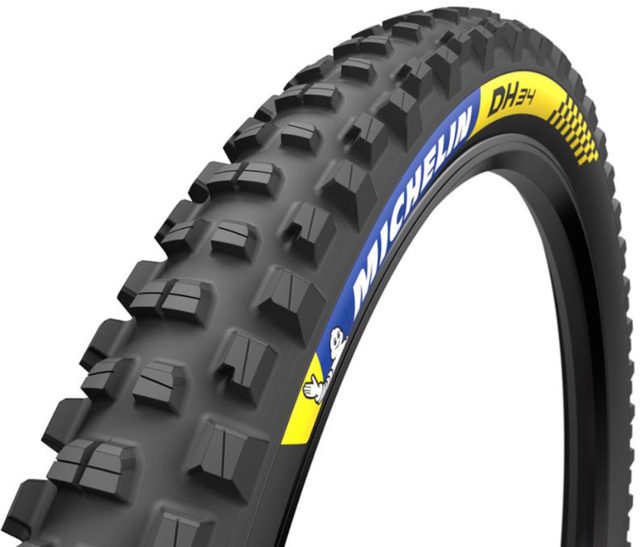
- Diameters available: 26", 27.5”, 29”
- Width available: 2.4”
The DH34 is Michelin’s faster-rolling counterpart to the DH22, meant for firmer conditions. The DH34 is still an aggressive tread though, and bears a bit of a resemblance to the Minion DHR II. Compared to the DHR II, the DH34 has a somewhat more ramped and open center tread, and slightly beefier, better-supported side knobs. In terms of performance differences between the two, rolling resistance is similar and the DH34 edges out the DHR II when it comes to cornering grip, especially on loose-over-hard surfaces, but doesn’t brake quite as well.
The DH34 comes in the same Downhill Shield casing and Magi-X Downhill rubber as the DH22, but as a result of having somewhat shorter knobs, it comes in more than 100 g lighter. But that still leaves it as the second-heaviest tire in this guide, just a few grams heavier than the notably bigger 2.5” Maxxis Assegai in a Downhill casing, 3C MaxxGrip configuration. I’m not at all mad about that for a true Downhill tire, and again, Michelin’s DH casings are notably beefy — even by the standards of the category — so riders who are hard on tires, take note. But I’d love to see a lighter, Enduro-oriented version offered as well.
Michelin does offer the DH34 in a less expensive “Bike Park” version, with harder rubber and more basic casing, which we haven’t yet tested. The stated specs below are for the standard, Magi-X DH + Downhill Shield version.
- Measured width for 2.4” tire, casing: 2.30”
- Measured width for 2.4” tire, tread: 2.38”
Front & Rear
Firm to mixed, especially hardpack and loose over hard
Michelin Wild AM2
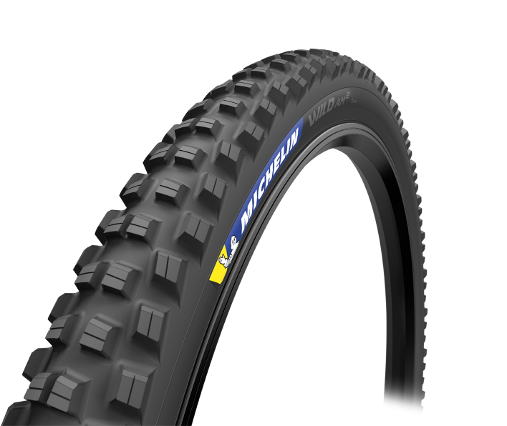
- Diameters available: 27.5'', 29''
- Width available: 2.4”
The Wild AM2 is a relatively new offering from Michelin, designed for use on mixed to loose terrain, and Trail / Enduro bikes. As tends to be the case with Michelin, it’s offered only in a single rubber compound and casing combination — in this case, their medium -soft “Gum-X” rubber and mid-weight “Gravity Shield” casing.
The knobs on the Wild AM2 are fairly square and blocky but not especially tall, and minimally siped. The leading edges of the center knobs are also substantially ramped to help with rolling resistance. The result is a tire that rolls surprisingly well, brakes very well for how well it rolls, and offers quite good grip on drier, looser soil in particular.
The not-crazy-soft rubber and extremely shallow sipes mean that the knobs on the Wild AM2 are well supported and not terribly squirmy on firmer surfaces, but also mean that grip is a bit more limited on wet roots and rocks in particular. Dry loose-over-hard is the strongest suit of the Wild AM2 — the knobs are spiky enough to dig in through the loose layer, but not so aggressive as to get squirmy when they find the harder surface beneath. Braking bite is good, which is especially valuable when it’s at such a premium, and the casing has proven to be reasonably durable for its weight.
There’s a substantial channel between the center and side knobs, but it doesn’t feel nearly as pronounced as on some other tires (e.g., the Minion DHF), so folks who have found those sorts of designs to require too much commitment to get over on edge shouldn’t necessarily write off the Wild AM2. The grip isn’t as consistent across lean angles as tires with large transition knobs (such as the Assegai) but it’s not as binary as it perhaps looks, either.
Gravity Shield
27.5” x 2.4”: 1041 g (average)
- Measured width for 2.4” tire, casing: 2.35”
- Measured width for 2.4” tire, tread: 2.39”
Front & Rear
Mixed to dry and loose
Versus
Versus All Mountain
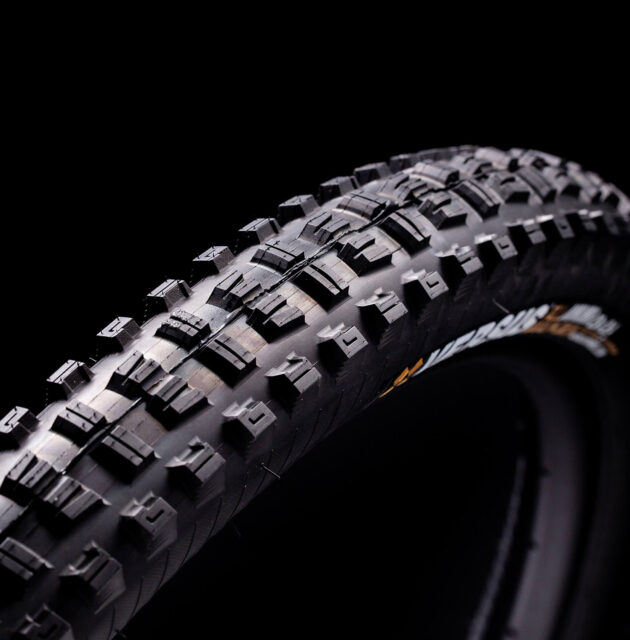
- Diameters available: 29”
- Width available: 2.4”
Versus’ lone tread pattern to date is simply called All Mountain, and it bears a significant resemblance to the e*Thirteen AT Gen 3, which we described as a bit like a mix of the Maxxis Minion DHF and Minion DHR II. As with all of those designs, the All Mountain features blocky center knobs with a substantial channel between the center and side knobs.
The knobs on the All Mountain are slightly taller than those of the AT Gen 3, which makes for a slightly slower rolling tire, but one that performs better in looser conditions than the e*thirteen. Compared to the Minion DHF, the All Mountain brakes slightly better, but can’t quite match it for cornering grip. The All Mountain rolls faster than the Minion DHR II, but has a touch less braking bite, and has a little less cornering grip.
Overall, though, the All Mountain is a strong offering, especially for riders looking for a faster-rolling variant on the Minion DHR II theme. A softer rubber option would be a nice option, especially for areas where wet roots are the norm, but apart from riders looking for the absolute softest, stickiest rubber, it’s a very good option.
The biggest limitation at the moment is that the All Mountain is currently only available in a 29” diameter. Versus had hoped to have a 27.5” version out by now, but Covid-related supply chain issues have pushed that release back.
Trail, Gravity
Trail, Grip
29’’ x 2.4’’, Trail Casing: 997 g (average)
- Measured width for 2.4’’ tire, casing: 2.33’’
- Measured width for 2.4’’ tire, tread: 2.28’’
Front & Rear
Specialized
Specialized Butcher
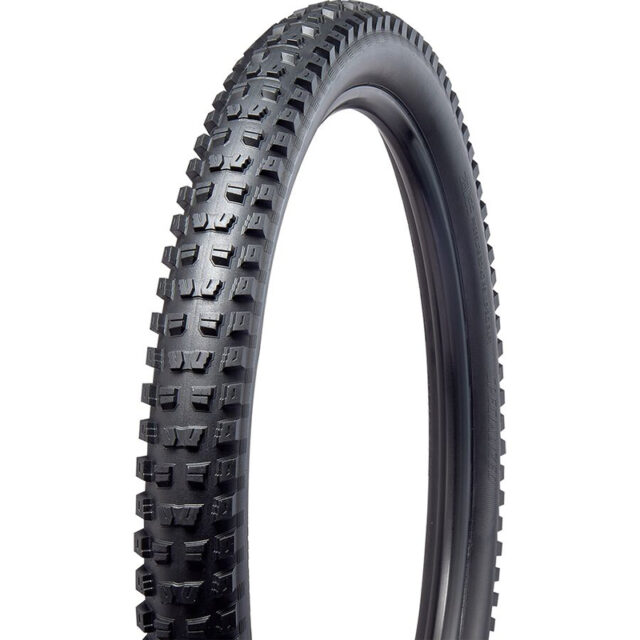
- Diameters available: 27.5’’, 29’’
- Width available: 2.3’’, 2.6’’
The Butcher has been in the Specialized lineup for a long time now, but just got an overhaul of its rubber compounds and construction and we’ve been testing the new Gripton T9 / Grid Trail version.
The Butcher bears a strong resemblance to the Maxxis Minion DHF, and its performance is reminiscent of that tire as well. Rolling resistance is similar, but the Butcher has an edge when it comes to braking traction; it also clears mud significantly better than the DHF. The DHF — especially in the very soft 3C MaxxGrip rubber — is a bit more predictable on very slimy wet roots and has slightly more cornering grip, particularly on very dry, loose surfaces, but takes a bit more commitment to get over onto the side knobs. Despite also having a significant open channel between the center and side knobs, the Butcher has less of a “dead zone” that you need to lean the bike through to get the side knobs to engage.
Compared to the Minion DHR II, the Butcher rolls better and grips better in very soft, wet conditions, but doesn’t brake as well. The Butcher is much faster rolling than the Magic Mary and is notably less squirmy on very firm trails, but doesn’t grip quite as well when things get very soft and loose.
Finally, it’s worth noting that, while the actual widths of the two sizes of the Butcher are closer than their nominal sizes would suggest (see our measured specs below), the 2.6’’ is much higher volume than the 2.3’’.
- 29’’ x 2.3’’, Grid Trail, Gripton T9: 1050 g
- 29’’ x 2.6’’, Grid Trail, Gripton T9: 1070 g
- Measured width for 2.3’’ tire, tread: 2.34’’
- Measured width for 2.6’’ tire, tread: 2.49’’
Front & Rear
Hutchinson
Hutchinson Griffus 2.4
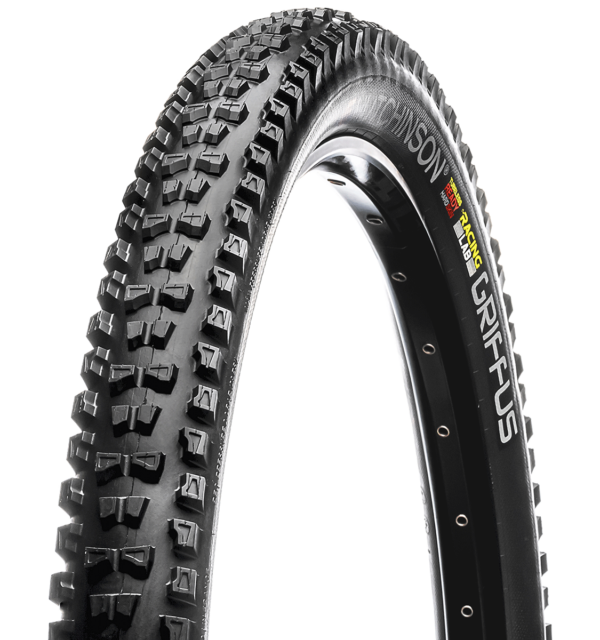
- Diameters available: 27.5’’, 29’’
- Width available: 2.4’’
The Griffus 2.4 is Hutchinson’s take on a fast-rolling rear tire that still offers considerable grip, and is suitable for aggressive riding. The center knobs are somewhat shorter than tires like the Maxxis Minion DHR II and quite heavily ramped to reduce rolling resistance. The Griffus 2.4 doesn’t have as much pedalling grip as tires like the Minion DHR II, WTB Judge, or Schwalbe Big Betty, but it rolls significantly faster than any of those three. It also brakes surprisingly well, given its modest center knobs, but does give up some braking bite compared to the DHR II and Big Betty in particular, especially in softer, looser soil.
Cornering grip is quite good for a tire that rolls as fast as the Griffus 2.4 does. The e.Thirteen AT Gen 3 is the closest tire in this guide to the Griffus 2.4, but the e.Thirteen feels a bit more oriented towards true hardpack, whereas the Griffus 2.4 grips a bit better in loose-over-hard conditions, especially under braking.
- Measured width for 2.4’’ tire, tread: 2.33’’
- Measured width for 2.4’’ tire, casing: 2.29’’
Most conditions short of very wet, especially if rolling resistance is a priority
Hutchinson Griffus 2.5
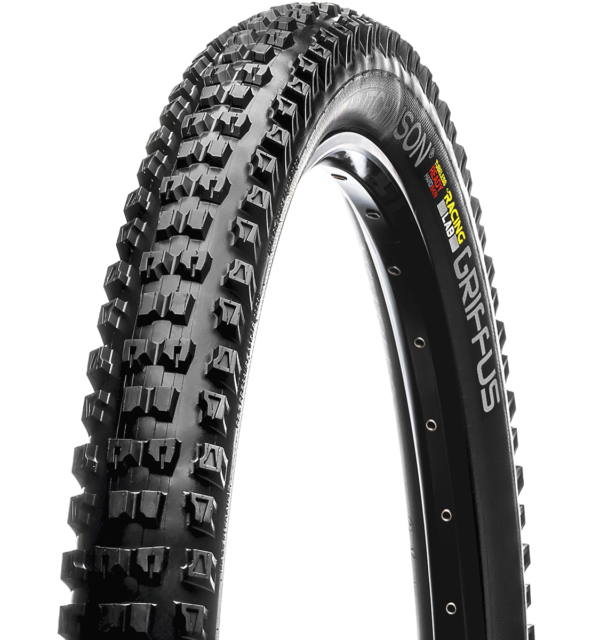
- Diameters available: 27.5’’, 29’’
- Width available: 2.5"
Despite sharing the Griffus name with the Griffus 2.4, the Griffus 2.5 is actually an entirely different tread pattern, meant primarily to be used as a front tire. It bears a significant resemblance to the Maxxis Minion DHF and Specialized Butcher, and its performance is reminiscent of a version of the Butcher, but oriented more towards drier conditions.
The Griffus 2.5 doesn’t inspire as much confidence as the Minion DHF on wet roots, especially with the very sticky 3C MaxxGrip rubber on the Minion, but the Griffus 2.5 rolls faster, brakes better, and is less squirmy on very hard trails — again, especially if the DHF is spec’d with the softer rubber options. Compared to the Butcher, the Griffus 2.5 has a little bit less cornering grip, especially in very soft soil, but it rolls better, feels less squirmy on hardpack, and is very close in terms of braking bite. It’s an excellent front tire for mixed to dry conditions, especially for riders who find very soft rubber compounds to be squirmy and vague in those circumstances.
- Measured width for 2.5’’ tire, tread: 2.42’’
- Measured width for 2.5’’ tire, casing: 2.40’’
Mixed to dry conditions, especially loose over hard.

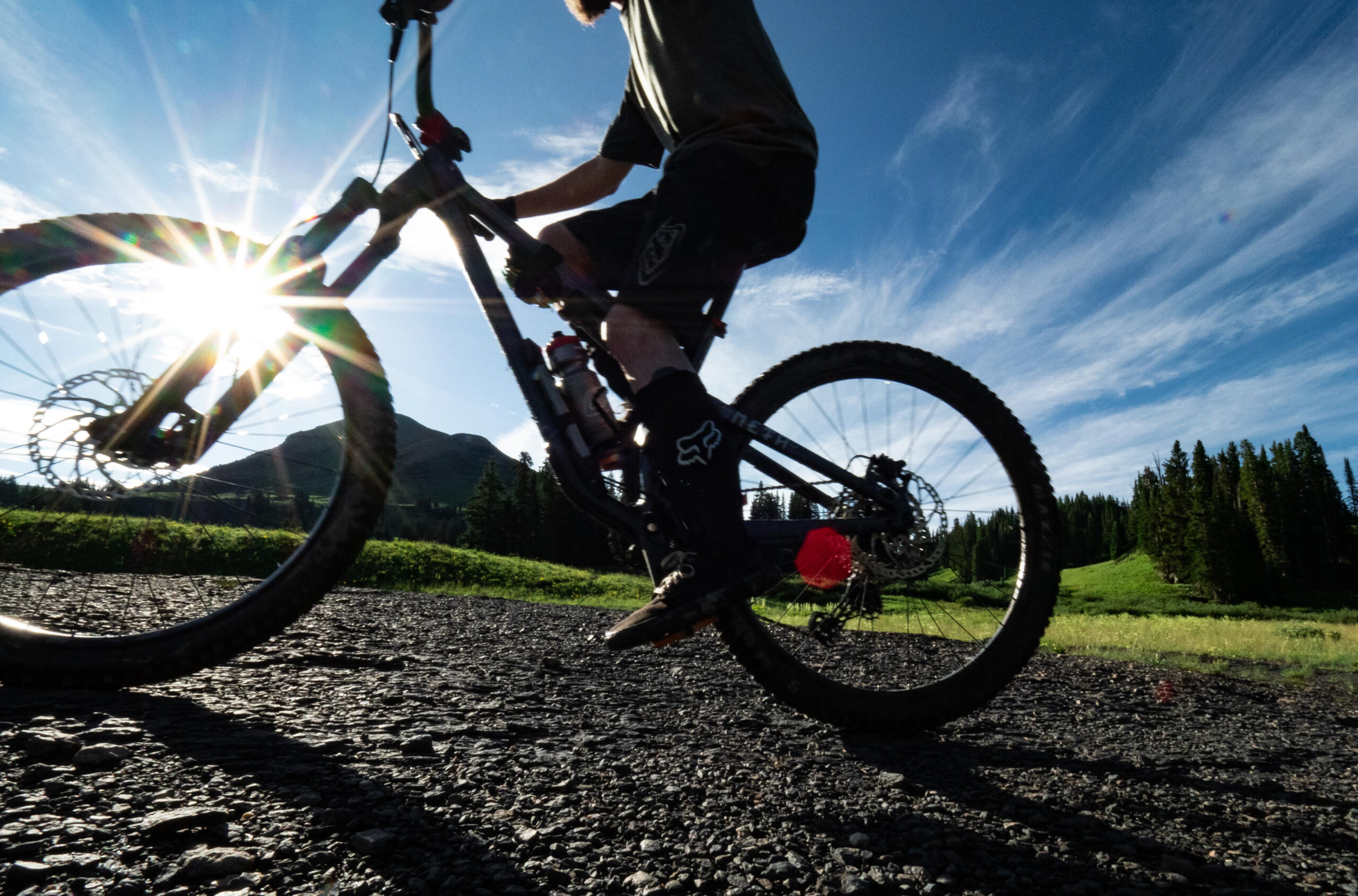
Funny, I have completely opposite opinions on the predictability of the Minion DHF and the Magic Mary: for me the Mary wins hands down for controllability on the edge. The DHF has surprisingly lost grip many times, whereas with the Mary I can most often do something about it before losing the grip, like easing a bit on cornering or sticking my foot out to save the day.
The Magic Mary is certainly popular, and I figured that somebody was going to bring that up. My take on that — which I tried to get at in the guide — is that the DHF requires some commitment to get over onto the side knobs, but once you’re there, it does break traction and initiate a drift predictably and controllably. If you try to get a lot of lateral grip out of it before the side knobs are solidly engaged, then it will break away quite easily. Dealing with that requires a degree of familiarity with the behavior, but once you’re used to it, they are very consistent.
The Mary, on the other hand, has pretty substantial transition knobs, so that effect of needing to roll the tire over past the open channel isn’t really there. With the DHF (or any number of other tires of a similar design), there’s a straightforward formula for controlling a drift by shifting body position and lean angle to engage the side knobs that the Mary doesn’t offer. I also think that the angle of the side knobs on the Mary plays a role here too. If you’re leaned over onto the side knobs, the leading edge of the knob is angled such that it helps pull you into the corner a little. BUT, if you do find yourself needing to take a stab of brake, the braking edge of the knob does the exact opposite. To quote Kevin Bazar’s High Roller II review, “And no, I don’t need to hear any lectures about braking while turning. I’ve watched some of the best racers in the world do it. Sometimes trails have surprises. Trails change, lines change, sometimes we screw up sections before a turn, get off line, whatever. Everyone does it at some point. Everyone.” The fact that the side knobs push in opposite directions (laterally) whether or not you’re feathering a brake makes them harder to manage in those oh-shit moments where you’ve overcooked a corner and are at the limit of grip to begin with.
If they’re working for you, by all means, keep running them. I’m not trying to convince anyone that their own, independently arrived at set of preferences is wrong. There’s undoubtedly a degree of personal preference and riding style that comes into play here. I still stand by my take that they’re less predictable near the limit.
As a long-time Maxxis loyalist who decided to give Schwalbe another chance once their new Addix compounds fixed their worst-in-class knob retention performance, I have discovered that transitional knobs are only half of the equation in the Magic Mary / Minion cornering discussion. The outer knobs of the Mary are not only rotated, they’re staggered at four different depths from the outer edge of the tread. On the Minion, the outer knobs are all parallel to the outer edge, & there are are just two staggering depths. What is more, the siping of the outermost blocks aligns nicely with the outer edge of the slightly-inset outer blocks so that when leaning a Minion, it feels like you are leaning on a single carving edge. Once engaged, the traction is there, locked on, ’till the tire simply lets go. With the Magic Mary, pushing that staggered outer row of blocks brings you into a zone where you begin to feel a slight “stutter” in carving grip. This is by design: the tire still has another ~10% traction/lean reserve before it lets go completely. For a Minion-trained rider, this feeling can initially trigger an “oh-shit” reaction, because if you were riding a tire w/ straight row of outer blocks, it would already be too late to correct. Schwalbe engineers call this stuttering/smearing behavior “Ankündigung des Grenzbereichs” (“signaling the limit”). On a Minion, the “death valley” transitional zone lets you know you’d better get all the way over on the side knobs, and then you’d better know just how much more lean is left before they let go. On a Magic Mary, there is a continuum of grip up ’till the tire “signals” you’re in that limit zone, and if you can fight the urge to panic, you’ve got another ~10deg. of lean. The design-based behavioral difference between these two DH treads also holds true when comparing the trail tires like the Nobby Nic to the Aggressor (Nobby Nic will scare a Maxxis rider sh*tless for the first few rides on dusty hardpack).
Great article, love your guys reviews !
Any ideas to look at Vittoria tires? Mazza / Agarro (and Martello) all are catching my eye. The Mazza is apparently a “minion beater” designed by the original creator of the Minion.
I’m a bit concerned I’m running “too much tire” with Assegai front and Dissector rear. Vittoria advertises their Agarro as “between an XC tire and Enduro tire” and I’m thinking of running 2.6 front 2.35 rear.
Listing the casing options and the rubber compounds separately is somewhat misleading as not all casing/compound/width combinations are available. It’s understandable though, because for some tires the amount of SKU’s is insane (DHF, for example). As someone who wants a chunky tread pattern with a high-volume dual ply casing and harder (Maxterra-ish) compound, there are frustratingly few options. The WTB judge is really the only readily available option for someone who want this combination of design elements (E:13 nonwithstanding; been there, done that, not willing to try again).
In my experience, the fast rolling compound on the Judge lasts a good while, even while riding like an idiot and doing way too many skids. IMO, it’s worth the similar (or maybe slightly less? IIRC it’s around $80) price versus a Maxxis Doubledown/DH casing tire because while the outright grip might not be quite as good (especially on hardpack/in the wet) it’s a rear tire so a bit of drift is fine, and it will last significantly longer than the Maxxgrip rubber on the more durable Maxxis casing options.
Some good tires for the “gnar”, but I’d argue that every one of them is overkill on the typical trail bike being used in the typical manner.
Just my two cents. I do see TONS of riders dragging these boat anchors around my local trails. It does not look enjoyable.
Love all the detail, though, guys. Keep it coming!
Yes and no.
There is a huge difference in riding terrain and style. ‘Trail bikes’ cover a broad spectrum.
I find that even with a 2.8” DHF up front, I still roll downhill on paved sections as fast or faster than my friends on a couple of long rides the last two years.
So, I think that rolling resistance of the front tire (as long as you are not going super soft), is not a huge deal. At the same time, our local trails are mostly rolling XC, but they get a fair bit of loose over hard, and lots of weird angled bedrock. Having a grippy tire in the front helps carry speed through the corners, which makes the following uphill a lot quicker.
But for places that mostly feature hardpack or hero dirt, especially if it is still rolling terrain, and bit faster rolling tire is a great option.
That’s the cool thing about tires, you can really change the feel of your bike to suit the terrain, for a very low investment.
Completely agree with Tjaard. Speaking from personal experience, I once ran Rekons for a week on wet, leafy conditions, thinking it’d be fine because it was “just singletrack”.
Never again.
Matt N, thanks for the info and explanation on Schwalbe’s “Ankündigung des Grenzbereichs” (“signaling the limit”), I guess that will apply to the newer Hans Dampf too.
Like Tom – I love the detail guys, please keep going with tires.
Michelin Wild Enduro Front and Rear may be contenders for the capable tire list?
Also, possibly, the newer design Schwalbe Hans Dampf as a rear (Mary upfront?).
I really like the Mary Addix soft in 29 upfront but never loved its predecessor the Trailstar version upfront when I was running a 650B front end.
Thanks for the article David, very comprehensive
We’ll have a Michelin update in a bit, including the Wild Enduro pair. We got product from them much later than the first four brands, but I’ve been spending a lot of time on several of their offerings and will include them in the guide soon.
David, that’s great, thanks. I’ll look forward to your opinions.
Hope you get to try them on your G16 – the Wild Enduro rear 27.5 interests me especially.
Mary soft 29 snakeskin works pretty well upfront for me.
What do you guys like best in Crested Butte’s typical dry conditions?
I know Eric Freson tends to be a fan of the DHF up front and something a bit faster-rolling out back, not sure if he has a really strong particular preference there though. I haven’t ridden nearly as many tires as our other reviewers, but I’ve been loving the Assegai up front since it gives me a bit more confidence leaning over (and also not *needing* to drastically lean over) the bike on our plentiful flat, loose-over-hard corners. For me and my not-super-aggressive style, the Assegai has been my favorite front tire so far for the trails here. Out back I’ve been running a Specialized Butcher but will likely switch to a DHR II at some point since its braking traction is notably better, and I think it corners a bit better, though I haven’t tried the 2020 version of the Butcher yet, which might narrow the gap a bit in terms of cornering traction.
Can you add the WTB Vigilante? You did review it.
And of course, a request to add some Bontrager and Specialized options. They make some very interesting tires in this space.
Seconded. I’ve been very happy with Specialized especially for rolling resistance
I haven’t ridden the Vigilante, but re-read Noah’s reviews of it, and based on his description it sounds a bit reminiscent of the Verdict, but with a slightly more rounded profile, and some transition knobs added to smooth the gap between the center and side knobs. I don’t want to speculate too much about a tire I haven’t ridden, but my hunch would be that the Vigilante rolls a little faster, and is likely a bit more predictable across varied lean angles, but gives up some braking bite and cornering grip, especially in very loose, dusty conditions.
It is worth pointing out that the siping is very different between the 2.3 and the 2.5/2.6/2.8 versions of the Vigilante. The bigger sizes have longitudinal sipes on most of the knobs, whereas the 2.3 has them going transverse. I do think the siping on the Verdict is maybe a bit too aggressive for the size of the knobs, and suspect that it contributes to some of the squirminess that I described.
Hey thanks for adding the Michelins. 4 interesting tyres.
Happy trails David.
I think a lot of opinions about tires are based to much on where you ride, for example i used to be a huge Minion DHF fanboy on till i tried the WTB verdict, i think its far better then the Minion in everyway, better grip when cornering hard, better in deep DG sand like we have here in Tahoe, on rock slab, super hard clay, moon dust, better braking and wears pretty good to for a soft tire, im on my second set since April, got about 500 miles on the first set. but thats how they work in my area, maybe not so much in yours.
Hi there, thank you
very much for the comparison. very interesting. Could you say a bit about how the Magic Mary and Assegai tires compare? cornering, rolling braking.
Thanks!
I’ve gone all in for Vittoria. The Mazza answers every gripe I had about the ballyhooed DHF. The Martello has proven itself over many blown out carcasses. Agarro is a short knobbed fast roller ideal for the rear in dry conditions. Mota is tops in super loose and muddy conditions. YMMV
Nice refresh on the tire guide. Some folks mentioned the Vittoria Agarro. As a trail casing rear, it makes more sense than just about any trail casing semi-slick. It rolls as fast and holds speed like an XC tire across flats and rises in dry conditions, but is also reassuringly versatile in mixed terrain and even wet conditions. It pairs well with an aggressive front tire when you want the speed of a semi-slick without the worry of semi-slick liabilities. It is a standout on naked rock whether wet or dry in climbing and traversing grip, at least at moderate speeds. (Grips pavement great too, lol.) Better than average grip on roots as a rear. Yet rolls great. Weaker points are braking on soil, mud clearing and lateral hold on soil– but on these dimensions it performs fine for fast trail riding, and braking bests a semi-slick. Really fast descenders pushing the limits of its trail casing could overwhelm its cornering grip. My best use case? A vacation consisting of long trail rides in places like PA, VA, VT or NC, where the rocks and roots are part of the fun, and fast rolling many miles is part of the fun– set it on rear and forget it. (When tried on front, feels like an XC race tire with extra weight, not an inspired choice, though someone crawling lots of rock might find it useful.)
What do you think of the Griffus 2.4 braking traction compared to a MaxxTerra or MaxxGrip DHF on the rear? I have a 2.5 DD MaxxGrip DHF on the back currently and find it’s braking grip good for my conditions (hardpack, rocky) but in DD casing and MaxxGrip compound, it’s not a quick roller!
And on the same token, it’s mentioned the Griffus 2.5 brakes better than the DHF even in MaxxGrip compound, yet rolls faster, this could be a good rear tyre for me! How close do you think the 2.5 Griffus is to a MaxxTerra or MaxxGrip DHR2 in braking?
Thanks!
Good questions. I tend to think that rubber compound doesn’t matter as much when it comes to braking grip (except for maybe on rock slabs) — the difference is more pronounced in lateral grip, especially on rock, wet roots, etc. The Griffus 2.4 brakes reasonably well on harder surfaces in particular. If things are pretty firm, it’s at least in the same ballpark as a DHF in one of the softer rubber compounds. The softer things get, the more it gives up, but if you’re running a 2.5 MaxxGrip DHF in back, in mostly firm conditions, and are happy with the braking performance, I think the Griffus 2.4 could be a really good option. It won’t give up much braking performance, but will roll much, much faster.
The Griffus 2.5 is a bigger, higher volume tire than I personally would want to run in the back most of the time, but if you’re happy with a 2.5 DHF there it would be viable too. It’ll just brake better and roll worse than the 2.4.
David thanks for that,
Both options sound really good, by the sounds of it, the 2.5 Griffus will roll faster, brake better and last longer than my Maxxgrip DHF, which for the rear end of my bike sounds perfect! I did enjoy the DHR2 I had previously on the back, in terms of braking grip, but overall prefer the DHF (volume, rolling speed)
My conditions although hardpack and rocky, do turn to blown up moondust during a dry race weekend, where I picture the 2.4 may struggle a bit, floating around in the loose soil.
By the sounds of the Ripost compound description, I will stick to my Maxxgrip Assegai or DHF up front, when it rains there is nothing worse than a front end struggling to stick to a wet rock, root or slick clay!
Hoping the Griffus side knobs bite well enough for my application in the rear!
Hey Mac O,
Did you end up going through with the griffus setup? currently on the assegai exo grip 2.5/dhr 2 exo+ terra setup and not sure what to try next. Riding conditions are mostly hardpack.
Currently looking at
– griffus 2.5/2.4
– tacky chan 2.4 front and rear ( ultrasoft front , soft rear in both supertrail casing)
– DHR 2 back and front 2.4wt front maxgrip/rear max terra
– kryptotal F/R enduro casing
What would be some good f/r alternatives for trail riding in forest with a mix of roots, loose gravel and some larger rocks in mostly damp conditions (after rainfall)? 27.5″ with 26mm rim width.
Some combo of MM/BB/HD perhaps?
You could try the lovely Bontrager G5 up front and a Shorty rear.
Or a Maxxgrip Shorty front. I have v1 Shortys and they are great. Grip on roots is good. But. It as good as the G5.
Or Mary supergravity extra soft front.
It’s good to have wet grip confidence on roots etc.
Hey @David, do you have a sense of how Schwalbe’s Super Gravity and Specialized’s Grid Gravity casings both compare to Maxxis DD? I still manage to kill DDs every now and then, and am hoping someone else has something with a little more puncture resistance. I’d love to run a Maxxis DH casing, but they only make it in fast-wearing slow rollign compounds, which is quite unfortunate given that MaxxGrip will last 4 rides in the Utah desert.
God what I would give for Maxxis to make a Dual compound minion or Dissector in DD or DH casing. The only DD/Dual combo right now is the aggressor, which is thoroughly meh.
I’m inclined to say that the Super Gravity casing is just a touch tougher than DD, especially when it comes to punctures through the center of the tread, but not by a huge margin or anything. Unfortunately I haven’t been able to get my hands on any Grid Gravity tires yet, so I can’t compare those.
Great summary. Really appreciate the comments on local conditions and rider preferences. I moved to the northeast after years in Rocky Mountain west and embarrassed to say it took a couple of seasons of occasional very hard falls to get over my ego and realize that everyone on local trails rode the dhf/dhf or dhf/dhr combo for very legit reasons over the magic mary, butcher or anything else. May not roll as fast, may not be fastest on any given Strava segment here but the margin of safety and consistency the maxxis dhf/dhf provide is worth it. It came down for me to- I may lose 1/2 sec every minute of dh to something else and a couple of seconds to every mile of climbing in the maxxis’ but the minutes lost laying it down once or gosh forbid busting something up and losing a number of rides in a season on an alternative bc of a crash that would not have happened on maxxis is just not worth it.
I’ve worn down my DHF’s to the casing and I’m looking to replace them with a similarly aggressive tire but that is longer lasting/ durable.
Any suggestions?
I live in AZ where the trails are dry, rocky, and sandy.
Great article, still find myself coming back to it after two years! Would be fantastic if you could do an update with the likes of the new Conti’s, Vee tyres etc. included.